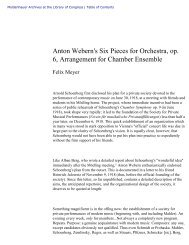Country Profile: Cuba - American Memory - Library of Congress
Country Profile: Cuba - American Memory - Library of Congress
Country Profile: Cuba - American Memory - Library of Congress
You also want an ePaper? Increase the reach of your titles
YUMPU automatically turns print PDFs into web optimized ePapers that Google loves.
<strong>Library</strong> <strong>of</strong> <strong>Congress</strong> – Federal Research Division <strong>Country</strong> <strong>Pr<strong>of</strong>ile</strong>: <strong>Cuba</strong>, September 2006<br />
a long and healthy life, having access to education, and a decent standard <strong>of</strong> living—<strong>Cuba</strong><br />
ranked an impressive fifth in Latin America and the Caribbean in 2003.<br />
Nevertheless, because government financial resources have contracted dramatically, the<br />
extensive and generous social safety net developed by socialist <strong>Cuba</strong> is currently incapable <strong>of</strong><br />
providing the protection for which it was designed. <strong>Cuba</strong> can no longer afford to provide the<br />
extremely liberal social and economic benefits that, in addition to full employment, traditionally<br />
included generous social entitlements such as early retirement (at age 60 for men, 55 for women)<br />
and a broad array <strong>of</strong> partially or wholly subsidized social services, such as public transportation<br />
and meals in government-owned cafeterias. Demographic trends further aggravate the erosion <strong>of</strong><br />
the safety net. With a rapidly aging population, the demands placed on the social safety net have<br />
multiplied as the number <strong>of</strong> elderly has increased.<br />
As much as 99 percent <strong>of</strong> the population (or at least 95 percent <strong>of</strong> the urban population and 78<br />
percent <strong>of</strong> the rural population) is reported to have access to safe water, one <strong>of</strong> the highest figures<br />
in Latin America. <strong>Cuba</strong>’s potable water is derived primarily (72 percent) from underground<br />
sources. Of the water supplied, 94 percent receives treatment. In 2000 an estimated 38 percent <strong>of</strong><br />
the population had access to sewerage systems and 55 percent to septic tanks and latrines. At the<br />
end <strong>of</strong> 2005, the country’s water distribution and sanitation systems reportedly were in dire need<br />
<strong>of</strong> repair.<br />
ECONOMY<br />
Overview: <strong>Cuba</strong> has a state-controlled economy with the exception <strong>of</strong> a tiny and shrinking openmarket<br />
sector. Since Fidel Castro seized power, a vast and cumbersome bureaucracy not<br />
conducive to innovation, productivity, and efficiency has managed <strong>Cuba</strong>n affairs. Since its<br />
collapse in the 1990s following the abrupt withdrawal <strong>of</strong> Soviet funding, the <strong>Cuba</strong>n economy has<br />
been recovering slowly and remains feeble. The sugar industry, traditionally the economy’s<br />
mainstay, is in decline, and the country now relies more on the nickel and tourism industries, as<br />
well as a barter arrangement with Venezuela under which <strong>Cuba</strong> supplies doctors and teachers in<br />
exchange for crude oil and petroleum products at a discounted rate. In the absence <strong>of</strong> large<br />
amounts <strong>of</strong> capital and access to markets and in the face <strong>of</strong> continued U.S. trade sanctions,<br />
<strong>Cuba</strong>’s economic situation is unlikely to improve substantially. During 2005, however, the surge<br />
in the availability <strong>of</strong> foreign exchange—as a result <strong>of</strong> new financing from China, trade<br />
agreements with Venezuela, and the continued strong growth <strong>of</strong> international tourism—enabled<br />
the government to increase state investment in projects such as repairing the critically dilapidated<br />
infrastructure and to increase wages and benefits.<br />
In addition to the formal economy, <strong>Cuba</strong> has a large informal, or second, economy. Informal<br />
economic activities include agriculture, where private farmers control a portion <strong>of</strong> the land; the<br />
sale <strong>of</strong> certain personal services; and, beginning in the early 1990s, farmers’ markets and artisan<br />
markets. Currently, about 300 farmers’ markets reportedly operate in <strong>Cuba</strong>. Other economic<br />
activities outside <strong>of</strong> state control include illegal activities such as black-market operations and<br />
unauthorized use <strong>of</strong> government resources. For example, there are extensive informal markets in<br />
the exchange <strong>of</strong> homes, which are <strong>of</strong>ten secured by making illegal payments through<br />
11



![Albert Einstein Papers [finding aid]. Library of Congress. [PDF ...](https://img.yumpu.com/21604228/1/190x245/albert-einstein-papers-finding-aid-library-of-congress-pdf-.jpg?quality=85)





![American Colony in Jerusalem Collection [finding aid]. Library of ...](https://img.yumpu.com/17941275/1/190x245/american-colony-in-jerusalem-collection-finding-aid-library-of-.jpg?quality=85)



![Piccard Family Papers [finding aid]. - American Memory - Library of ...](https://img.yumpu.com/17941234/1/190x245/piccard-family-papers-finding-aid-american-memory-library-of-.jpg?quality=85)


